
© Julieta Cervantes. (Click image for larger version)
The Forsythe Company
Sider
New York, Brooklyn Academy of Music
12 October 2013
www.theforsythecompany.com
www.bam.org
Systematic – William Forsythe’s Sider at the Brooklyn Academy of Music
No-one will ever accuse the American-born choreographer, William Forsythe, based in Germany since the seventies, of taking the easy way – on the contrary, he is a master of complexity. Most people know him for his radical re-interpretations of ballet, works like Artifact (1984) and Impressing the Czar (1988). But, especially since leaving Ballet Frankfurt and forming his own troupe, The Forsythe Company, in 2005, his works have increasingly left ballet far behind. Classicism is now a distant point of reference, expressed mainly in the extreme articulateness of the dancers’ bodies. Forsythe’s interests seem to lie elsewhere, in the creation of complex systems through which to organize material (movement, sounds) produced through improvisation. The material itself consists of idiosyncratic phrases that seem to contradict the normal laws of locomotion – as if the dancers were grappling with their own bodies and with physics – woven through with text.
Like those of a computer programmer, Forsythe’s systems are regulated by a constant stream of minute decisions. What will the dancers do next? How quickly? What will the lights do? What will the audience be allowed to see? What will they hear? Sometimes there is an underlying thematic thread – in Three Atmospheric Studies it was the Iraq war, in Decreation it was love. But in other works, like Sider (2011), which just completed its run at the Brooklyn Academy of Music, the ultimate goal is not, or does not seem to be, a coherent thematic arc. As Forsythe said at a talk before the Oct. 12 performance, “I lack the narrative gene.” This is clear to anyone in the audience. Structure, rather than content, is the point.
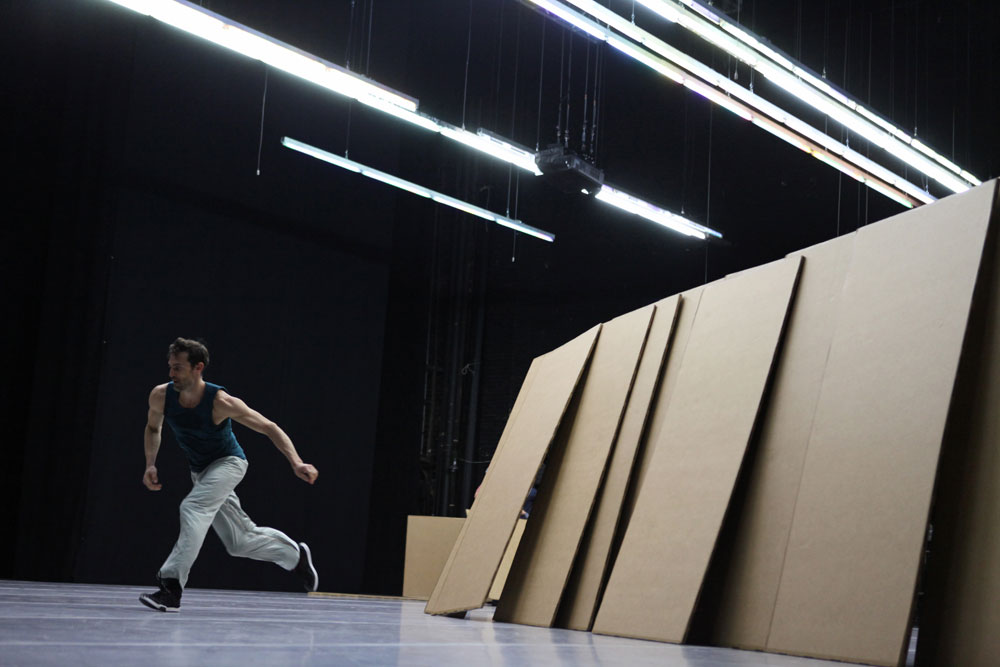
© Julieta Cervantes. (Click image for larger version)
Sider, a seventy-minute work performed without intermission, is the latest of Forsythe’s explorations of the “if this, then that” format, which date back at least as far as One Flat Thing Reproduced (2000). Watching them is a bit like observing the behavior of an extremely precise, proficient group of technicians endowed with an extreme form of Obsessive Compulsive Disorder. (Forsythe’s dancers are astonishing and possess almost incomprehensible physical courage. To see them slashing through the air and falling straight down to the ground from a jump is to worry a little bit about their sanity, and their knees.) They are intensely busy but we do not – and I would argue, cannot – decipher why they do what they do.
The program notes to Sider, if one has the foresight to read them, provide some valuable context. Through hidden earpieces, it explains, the dancers are being fed dialogue from an Elizabethan play, unnamed. A pre-show talk I attended revealed the play to be the 1969 film of Hamlet with Marianne Faithfull as Ophelia and Nico Williamson as Hamlet. (Why not just come out and say so?) But for the most part the audience is not aware that the dancers are listening to actors delivering lines from Hamlet, or even that it is Shakespeare. Their movements are interpretations of the aural patterns – not the literal meanings – of the actors’ lines, which form a kind of verbal score. (This is not so difficult to imagine: Shakespearean acting is, in its way, operatic.) Each dancer comes up with his or her interpretation of the patter. However, these variegated patterns are subject to instructions from Forsythe, delivered to the dancers in real time, again through their earpieces. Essentially, he “conducts” his dancers: faster here, slower there, with more or less articulation.
But there are further patterns at play: A system of light cues – on, off, flickering, dimming, brightening – acts like a complicated form of traffic control. The dancers stop, start, stop, start, freeze, move on. Yet another system of cues is communicated via clapping sounds from the wings. Further, one of the dancers, David Kern, delivers a series of soliloquies in a melodic gibberish that in some ways echoes the modulations of the text. Like most of the other performers, he wears tights and a balaclava; his are pink. The costumes, by Dorothee Merg, vaguely reference medieval dress, via twenty-first-century rehearsal-wear. A few people wear ruffs. Let’s call it casual medieval. Like everything else, the patter is anything but random. But Kern’s slightly priggish delivery seems to imply that its content shouldn’t be taken too seriously. Kern also holds a placard printed with the words “in disarray.” A hint?: in Hamlet, the melancholy prince appears to Ophelia in a state of disarray. More words are projected above the dancers’ heads at various intervals: “she is to them as they are to us”; then “is and isn’t”; and finally, “they were and they weren’t.” Those who attended the talk will know that they refer to Hamlet’s famous “to be or not to be” soliloquy. The un-prepared viewer, however, has no way of knowing this.
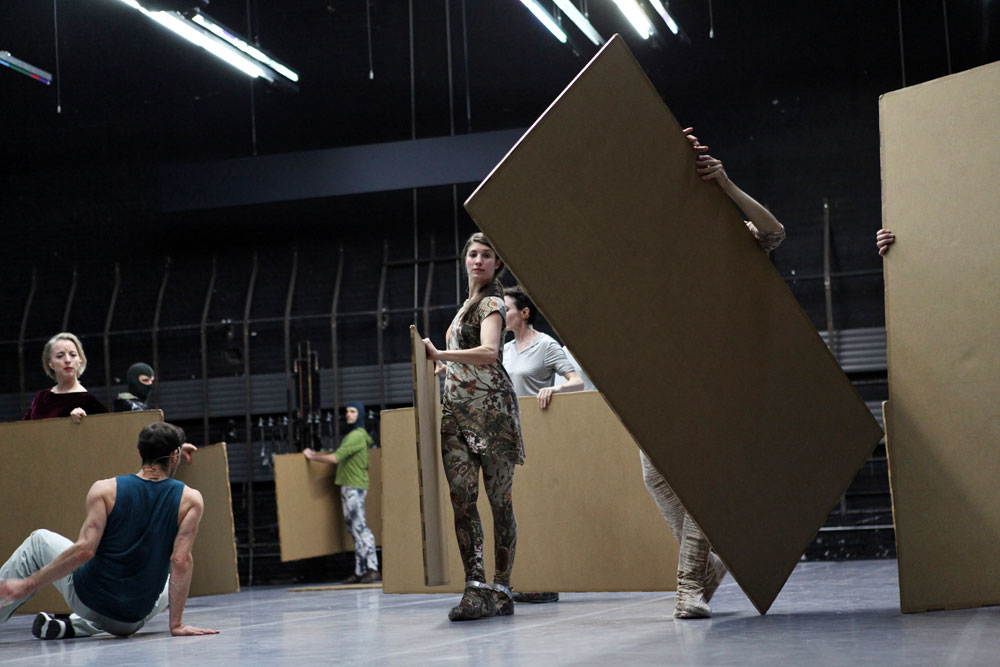
© Julieta Cervantes. (Click image for larger version)
According to Forsythe, the phrases are meant to “underscore the drama’s themes of analogy and obscuration.” If so, it’s time I reread my Hamlet. In any case, obscuration is much on Forsythe’s mind, as it has been in previous works like Kammer/Kammer. In that work, walls partially obstructed the audience’s view of activity onstage. Here, the walls consist of large cardboard rectangles, which the dancers drag around, twirl, kick, and assemble into structures within which the entire cast disappears. As in One Flat Thing, these surfaces become the baseline for endless variations. A man pushes a woman using a cardboard slab as a kind of blunt shovel. Two men fight, the board between them like a shield. Toward the end, the entire company drums out rhythms on the rectangles, like a cardboard xylophone.
There are structures built upon structures. And to contain them, Forsythe uses the most basic western structure of them all: A-B-A, the sonata form. The piece ends as it begins, with Frances Chiaverini manipulating her rectangle of cardboard and peering into the darkness as Fabrice Mazliah crawls and slides at her feet, in front of, around, and behind the obstruction. Chiaverini moves about in a kind of dreamy fog, her steps loopy, elastic, and sustained even as the others tagger, skip, skitter, and spiral around her. Mazliah plays the role of a confused searcher, weaving through the littered landscape. In a rare moment of clarity and quietude, the two sit together off to the side, whispering, smiling, flirting a little, like real people. This small, private moment is, for me, the highlight of Sider.

© Julieta Cervantes. (Click image for larger version)
The problem is that, for all its formal intelligence, Sider is essentially an ungenerous, sterile work. It may be fascinatingly complex to its performers, who are also its creators, and to those who, like Forsythe, are content to observe the underlying logic that underpins a work of art. But if one wants more – meaning, feeling, or even communication – one won’t find it here. What’s more, there is something slightly creepy about the control Forsythe exerts over his dancers through constant aural stimulation, delivered directly into their bodies through earpieces. Performance is the one time that artists are, at least in some measure, free. Forsythe does not allow them even that. He limits the audience’s freedom as well, by placing extreme restrictions on our understanding; without a sense of what is motivating the action, it is difficult to feel physical or moral empathy with anything happening on the stage. Sider is infinitely clever, but boring.












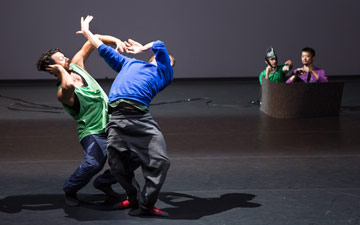
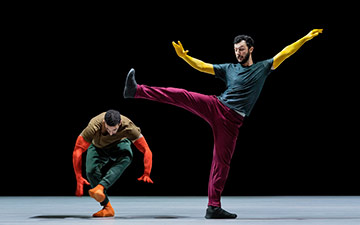
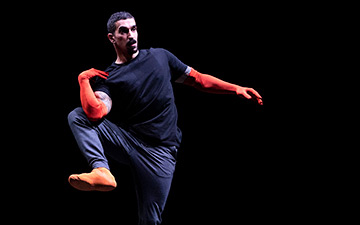

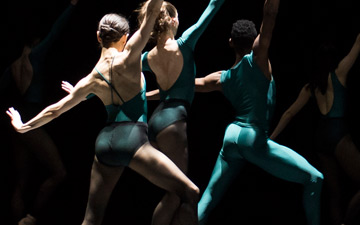
[…] The Forsythe Company performed William Forsythe’s Sider at BAM last week. As he explained, much of the dancers’ movement is set to the speech patterns of actors reciting an “Elizabethan tragedy”, being fed to them in real time through earpieces. The audience does not hear the text. Those who attended a pre-performance talk will know that the tragedy was Hamlet. (Most people will not.) Here’s my review of the piece for DanceTabs. […]
So… basically, if you don’t understand what it means it’s your own fault, eh?
I’ll never forget my first experience seeing his work in Frankfurt back in the early eighties. I left scratching my head and wondering what it must be like to be “dancing” in his work. I think I would not have been able to last long.
And those were the “straightforward” pieces!